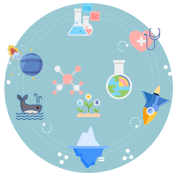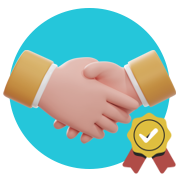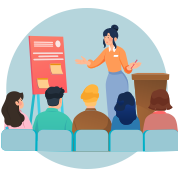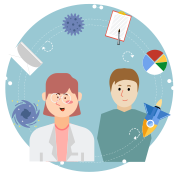The Power of Networking in the Scientific and Illustration Communities
Networking with professionals in the scientific and illustration communities is like casting a wide net into a sea of opportunities. It's a strategic move that holds immense importance in expanding your reach and advancing your career. Let's delve into why this practice is a game-changer:
Cultivating a Vibrant Ecosystem:
1. Knowledge Exchange: Networking creates a fertile ground for sharing insights, experiences, and knowledge. Connecting with fellow illustrators and scientists allows you to tap into a wealth of expertise and stay updated on industry trends.
2. Diverse Perspectives: Interacting with professionals from various fields infuses your work with diverse perspectives. It adds depth and richness to your illustrations by exposing you to different approaches, styles, and subject matters.

Mutual Growth and Learning:
1. Skill Enhancement: Engaging with experts nurtures continuous learning. Workshops, seminars, and discussions offer a platform to hone your craft, acquire new techniques, and refine your skills.
2. Adaptability: The scientific and illustration landscapes are ever-evolving. Networking keeps you adaptable by introducing you to emerging tools, technologies, and methodologies.
Collaborative Opportunities:
1. Synergistic Projects: Building relationships with scientists can lead to collaborative projects. Your visuals complement their research, and their expertise enriches your visual storytelling.
2. Interdisciplinary Magic: In the realm where science meets art, the possibilities are limitless. Networking exposes you to interdisciplinary collaborations that yield innovative and captivating creations.
Visibility and Brand Building:

1. Showcasing Your Portfolio: Networking events and online platforms provide opportunities to showcase your portfolio, gaining exposure and attracting potential clients.
2. Referral Network: When scientists and fellow illustrators trust your work, they become a valuable source of referrals. Word-of-mouth recommendations can significantly expand your client base.
Inspiration and Motivation:
1. Creative Fuel: Interacting with like-minded individuals fuels your creativity. Exposure to others' work and achievements ignites fresh ideas and keeps your creative spark alive.
2. Shared Goals: Surrounding yourself with professionals who share your passion fosters motivation and a sense of belonging. It reminds you that you're part of a thriving community.
Career Advancement:
1. Professional Growth: Networking can open doors to opportunities you might not have discovered otherwise. It could lead to speaking engagements, collaborations, or even career-defining projects.
2. Mentorship Possibilities: Connecting with seasoned professionals could lead to mentorship relationships. Learning from their experiences can guide you toward making informed career decisions.
Conclusion
In a nutshell, networking is a dynamic force that propels you forward. It's a catalyst for growth, both personally and professionally. By forging connections with fellow illustrators and scientists, you're weaving a tapestry of possibilities that expand your horizons and amplify your impact. So, embrace networking as a cornerstone of your journey, and watch your reach and influence flourish.

Techniques to Expand Your Reach Through Networking
Networking is a powerful tool that can open doors to new opportunities and collaborations. Engaging with professionals in the scientific and illustration communities not only enhances your skills but also broadens your horizons. Here are some effective techniques to help you achieve meaningful networking:

1. Attend Industry Events:
Participate in conferences, workshops, seminars, and exhibitions related to scientific illustration. These events provide a platform to connect with experts and enthusiasts, exchange ideas, and showcase your work.
2. Online Communities:
Join social media groups, forums, and online platforms dedicated to scientific illustration and relevant scientific fields. Engage in discussions, share your insights, and connect with like-minded professionals.
3. Collaborative Projects:
Seek out opportunities to collaborate with scientists, researchers, or fellow illustrators on projects. Collaborations not only expand your network but also expose you to different perspectives and skill sets.
4. Workshops and Classes:
Enroll in workshops or courses focused on scientific illustration. These environments facilitate networking by bringing together individuals who share your passion for the craft.
5. Attend Art Exhibitions:
Display your work at art galleries or exhibitions related to science and nature. Engage with visitors, fellow artists, and potential clients who appreciate the fusion of art and science.
6. Local Meetups:
Look for local art or science-related meetups in your area. Meeting face-to-face with professionals fosters more personal connections and allows for meaningful conversations.
7. Cold Outreach:
Reach out to professionals whose work you admire through emails or social media. Express your interest in their work and inquire about the possibility of connecting or collaborating.
8. Webinars and Web Conferences:
Attend online webinars or virtual conferences focused on scientific illustration. These platforms offer networking opportunities and insights from experts in the field.

9. Create a Strong Online Presence:
Maintain an updated portfolio website and social media profiles that showcase your work. Engage with your audience and share valuable content related to your niche.
10. Alumni Networks:
If you've attended relevant educational institutions or programs, tap into alumni networks for potential networking opportunities.
11. Professional Organizations:
Join associations or organizations dedicated to scientific illustration or your specific area of interest. These groups often host events and offer networking platforms.
12. Offer Workshops or Talks:
Share your expertise by conducting workshops, giving talks, or hosting webinars on scientific illustration. These activities position you as a knowledgeable professional and attract connections.
13. Research and Outreach:
Identify experts or scientists whose research aligns with your interests. Reach out with personalized messages, expressing your admiration for their work and your desire to connect.

14. Mutual Interests:
Identify shared interests beyond work, such as hobbies or causes. Connecting on a personal level can lead to lasting professional relationships.
15. Volunteer or Collaborate:
Offer your skills to contribute to scientific or educational projects. Volunteering can provide exposure, valuable connections, and a sense of contribution.
Conclusion
Remember, successful networking is built on authenticity, genuine interest, and meaningful interactions. Approach each connection with a willingness to learn and share, and you'll find that your reach in both the scientific and illustration communities expands organically.
Engaging in Thought Leadership
Becoming a thought leader in the field of scientific illustration not only positions you as an authority but also amplifies your reach and credibility.
By actively participating in thought leadership activities, you can contribute valuable insights, inspire others, and elevate your professional standing. Here's how to embark on this journey:
1. Write Compelling Content:
Craft insightful articles, blog posts, or whitepapers on topics related to scientific illustration. Share your knowledge, tips, and experiences to provide value to fellow professionals and enthusiasts.

2. Guest Speaking and Webinars:
Collaborate with organizations, conferences, or online platforms to deliver talks, webinars, or workshops. Sharing your expertise in public forums demonstrates your thought leadership and enhances your visibility.
3. Social Media Engagement:
Consistently share informative and thought-provoking content on your social media platforms. Engage in discussions, comment on relevant posts, and showcase your unique perspective.
4. Publish Research and Case Studies:
Conduct research or case studies related to scientific illustration techniques, challenges, or trends. Publishing your findings adds a scholarly dimension to your thought leadership.
5. Offer Insights Through Podcasts:
Participate in podcasts or start your own to discuss scientific illustration insights, techniques, and experiences. This audio medium allows you to reach a diverse audience.
6. Host Workshops and Masterclasses:
Organize workshops or masterclasses that provide hands-on learning experiences. Sharing your expertise in a practical setting establishes you as a trusted source of knowledge.

7. Thoughtful Commentary:
Provide thoughtful commentary on emerging trends, news, or breakthroughs in scientific illustration. Your unique perspective can spark engaging discussions and showcase your expertise.
8. Collaborate on Research Projects:
Collaborate with scientists, researchers, or experts on projects that merge art and science. These collaborations offer a platform to contribute your visual expertise to groundbreaking research.
9. Create Educational Resources:
Develop educational resources such as e-books, tutorials, or online courses. Sharing your knowledge in accessible formats positions you as a mentor and educator.
10. Offer Consultations:
Provide consultation services to fellow illustrators, students, or professionals seeking guidance. Your insights and advice can become sought-after resources in the field.
11. Networking and Panels:
Participate in industry panels, roundtable discussions, or forums where you can share your perspective and engage in meaningful conversations.
12. Regular Newsletters:
Curate and share curated insights, updates, and resources through a regular newsletter. This consistent communication builds a loyal following and showcases your expertise.
13. Write for Industry Publications:
Contribute articles or columns to industry magazines, journals, or websites. Publishing on reputable platforms enhances your credibility and reach.

14. Address Industry Challenges:
Address common challenges faced by scientific illustrators and offer innovative solutions. This demonstrates your ability to think critically and contribute to industry advancement.
Conclusion
By embracing thought leadership activities, you're not only elevating your personal brand but also contributing to the growth and development of the scientific illustration community. Your expertise becomes a beacon of guidance, fostering a culture of continuous learning and innovation.
